The goal on our most recent trip was an exotic sounding place in Yuba County, Timbuctoo. Other than an unusual name we knew little about it. We leave with the idea that we would try and find any signs of the old emigrant trail that once passed along this general direction. Other than those goals we left ourselves open to whatever the road would reveal to us on that day.
Camp Far West is a few miles east of Wheatland, a small town on the east side of the Central Valley. It was an army outpost during the emigration days in the later 1840s and early 1850s. Located just a few miles from Johnson's Ranch, which was the fabled end of the trail for many California bound travelers. Once you reached Johnson' Ranch, you’d made it! We wanted to try and follow as much of the old trail as we could, as it wound its way in the general direction from near Timbuctoo. We would keep our eyes open for wagon ruts, trail signs, or any other indication we were on the right path.
Monica walks among the Graham Hotel and Truckee Trail markers. Graham’s hotel stood for many years servicing travelers over the old road. yo can see the wagon ruts headed over the hill in the background.
We visited the Truckee trail "T Marker" and sign for Grahams Hotel by Lake Camp Far West. At this place, the wagon ruts can be seen headed down the hill. We would try and follow the trail back from here so we headed up Camp Far West Road which we felt would give us a view of the wagon ruts on the other side of the hill. They were easy for us to spot as we knew they were coming our way, and we've gotten better at detecting these old trails. Often they are more of an impression of a trail than an obvious path, as they have generally not been traveled on for well over 15 years. Sometimes erosion wears the track into more of a gully, and other times the ruts are still quite visible. The ones coming over the hill here are in between easy to see and hard. More of a swale than a path actually, but quite obvious when we know the trail came over the hill this direction.
You can see, though very faint, the two tracks headed from the hill in the back, towards the hill directly in front. These tracks were made by thousands of metal rimed wooden wheels carrying emigrant and others wagons. Camp Far West Reservoir is just over that ridge.
Now we headed up Camp Far West Road towards a name on the map, Waldo. Waldo was known initially as Cabbage Patch, named for the cabbages that were grown to sell to travelers. We had read that Waldo or Cabbage Patch was a way-point along the old wagon road. We found out after the trip there is even a Cabbage Patch Cemetery, which we will try and find on our next trip.
I wonder what’s down that road?
At Waldo, we decided to take a side trip, which is something we do all the time. Our destination is more of a hope than written in stone. If we don't make it because something else has come up, that's OK. The secret to finding these old sites and what they hold is a willingness to change plans during the adventure. We decided to check out another name on the map, Spenceville, located down that road.
Our first inkling that Spenceville held more surprises for us, a abandoned bridge going from where to where? It wasn’t the only bridge we happened upon.
In my next post we’ll discuss Spenceville and the finds we made there!




